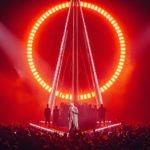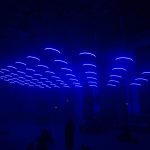Just the other day I was driving along, just another contestant in the rat race, navigating all those little mazes, when all of a sudden, out of nowhere, a car that had been driving along in the lane right next to me swerved into my lane and almost rearranged my left front fender. The little rat that was driving had decided to make a U-turn, and he swung very wide to make the turn, very nearly denting my chariot. He looked left and swerved right when he should have looked right and stayed left. Inevitably, when you don’t watch where you’re going, you’re going to cause a train wreck. The same thing applies to running a console. When you push a button, you should be watching what’s going on onstage rather than looking down at your console. Otherwise, the train could jump the tracks and you might not even know it.
Lighting is a dynamic art. It moves, it changes, it morphs, it dances and plays. At times, the changes are imperceptible, like the sun moving across the sky. But most of the time, the transitions are the defining moments in a show. The beginning, the end, and all those changes in between, are very important.
By now, we’ve all gotten the message about the way the brain works. “Aoccdrnig to rscheearch at Cmabrigde Uinervtisy,” goes the e-mail, “it deosn’t mttaer in waht oredr the ltteers in a wrod are, the olny iprmoatnt tihng is taht the frist and lsat ltteer be in the rghit pclae. The rset can be a taotl mses and you can sitll raed it wouthit a porbelm. Tihs is bcuseae the huamn mnid deos not raed ervey lteter by istlef, but the wrod as a wlohe.”
I wouldn’t go as far as to say that, in lighting, the only important thing is the transitions. But it just might be the single most important thing. The most beautiful, creative looks in the world without rhythm or timing will produce a show with an awkward feel. If you’ve ever pushed the wrong button at the wrong time and caused a huge transition at a totally inappropriate time, then you know just what I’m talking about. I once pushed the wrong button during a slow song, and instead of fading into the next cue, the console jumped back to the previous cue with no timing, just a hard cut. It caused the stage to go from a meditative blue to a flash of bright white. The singer almost choked on the lyrics and his fingers just about tripped over the keyboard. He paused ever so slightly and glanced up at the lights. I felt like crawling under the console. It’s all about the transitions.
Which leads us back to the train wreck. When you’re first starting out, it’s a natural inclination to look at the button you’re pushing rather than at the stage. Sometimes you don’t even realize that you’re doing it. It took me a long time to realize what I was doing. But watching the console instead of the stage is a mistake. When you push the button, the action takes place on the stage, away from the console. That’s where you should be looking. Once you press the button, it doesn’t hurt to look down at your console notes to make sure the next cue is the one you think it is. But before you press the button again, look up.
When you watch the transitions onstage, a whole new world opens up in front of your eyes. You start to get a good sense of the timing of cues. Once you realize the power of a well-timed cue, then you can start to understand why certain designers and lighting operators are in heavy demand. Brian Hartley is a prime example. If you’ve ever watched him run a TSO show or a KISS show, then you’ve seen the best at work. Lenny Kravitz did, and that’s how Brian came to design and operate Kravitz’s shows. He insisted on hiring Hartley — no one else would do — because he recognized the incredible timing of the show. And if you’ve ever watched Hartley work, then you might have noticed that he’s watching the stage, not the console.
Lighting is one part design, one part programming and one part operating. If any of those parts are not carefully executed, then the entire show suffers. Operating a lighting console is not difficult, provided you know the cues and you can push a button without looking at it. Timing is…everything.
Now is the time to e-mail the author at rcadena@plsn.com.


